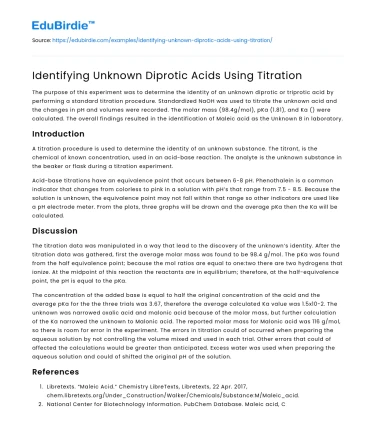Table of contents
- Introduction
- Discussion
- References
The purpose of this experiment was to determine the identity of an unknown diprotic or triprotic acid by performing a standard titration procedure. Standardized NaOH was used to titrate the unknown acid and the changes in pH and volumes were recorded. The molar mass (98.4g/mol), pKa (1.81), and Ka () were calculated. The overall findings resulted in the identification of Maleic acid as the Unknown B in laboratory.
Introduction
A titration procedure is used to determine the identity of an unknown substance. The titrant, is the chemical of known concentration, used in an acid-base reaction. The analyte is the unknown substance in the beaker or flask during a titration experiment.
Save your time!
We can take care of your essay
- Proper editing and formatting
- Free revision, title page, and bibliography
- Flexible prices and money-back guarantee
Acid-base titrations have an equivalence point that occurs between 6-8 pH. Phenothalein is a common indicator that changes from colorless to pink in a solution with pH’s that range from 7.5 - 8.5. Because the solution is unknown, the equivalence point may not fall within that range so other indicators are used like a pH electrode meter. From the plots, three graphs will be drawn and the average pKa then the Ka will be calculated.
Discussion
The titration data was manipulated in a way that lead to the discovery of the unknown’s identity. After the titration data was gathered, first the average molar mass was found to be 98.4 g/mol. The pKa was found from the half equivalence point; because the mol ratios are equal to one:two there are two hydrogens that ionize. At the midpoint of this reaction the reactants are in equilibrium; therefore, at the half-equivalence point, the pH is equal to the pKa.
The concentration of the added base is equal to half the original concentration of the acid and the average pKa for the the three trials was 3.67, therefore the average calculated Ka value was 1.5x10-2. The unknown was narrowed oxalic acid and malonic acid because of the molar mass, but further calculation of the Ka narrowed the unknown to Malonic acid. The reported molar mass for Malonic acid was 116 g/mol, so there is room for error in the experiment. The errors in titration could of occurred when preparing the aqueous solution by not controlling the volume mixed and used in each trial. Other errors that could of affected the calculations would be greater than anticipated. Excess water was used when preparing the aqueous solution and could of shifted the original pH of the solution.
References
- Libretexts. “Maleic Acid.” Chemistry LibreTexts, Libretexts, 22 Apr. 2017, chem.libretexts.org/Under_Construction/Walker/Chemicals/Substance:M/Maleic_acid.
- National Center for Biotechnology Information. PubChem Database. Maleic acid, CID=444266, https://pubchem.ncbi.nlm.nih.gov/compound/444266 (accessed on Apr. 30, 2019)
Did you like this example?
Make sure you submit a unique essay
Our writers will provide you with an essay sample written from scratch: any topic, any deadline, any instructions.
Cite this paper
-
APA
-
MLA
-
Harvard
-
Vancouver
Identifying Unknown Diprotic Acids Using Titration.
(2022, February 21). Edubirdie. Retrieved March 1, 2025, from https://edubirdie.com/examples/identifying-unknown-diprotic-acids-using-titration/
“Identifying Unknown Diprotic Acids Using Titration.” Edubirdie, 21 Feb. 2022, edubirdie.com/examples/identifying-unknown-diprotic-acids-using-titration/
Identifying Unknown Diprotic Acids Using Titration. [online].
Available at: <https://edubirdie.com/examples/identifying-unknown-diprotic-acids-using-titration/> [Accessed 1 Mar. 2025].
Identifying Unknown Diprotic Acids Using Titration [Internet]. Edubirdie.
2022 Feb 21 [cited 2025 Mar 1].
Available from: https://edubirdie.com/examples/identifying-unknown-diprotic-acids-using-titration/
copy






 Stuck on your essay?
Stuck on your essay?

